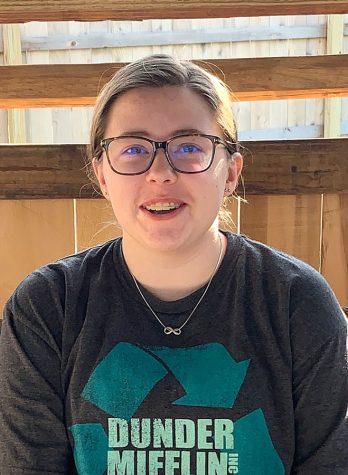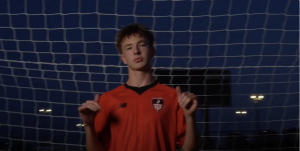‘The Haunting of Bly Manor’ provides a ‘switching’ scare

October 29, 2020
My affinity for horror films and shows has been growing with me since I was younger. When I heard a new horror-inspired show was coming to Netflix, I was excited to clear my schedule. “The Haunting of Bly Manor,” rated TV-MA and is nine episodes long, was brought to Netflix on Oct. 9. The show is loosely based on an 1898 novella, “The Turn of The Screw,” by Henry James. Mike Flanagan is known for his horror projects and is the creator of both Netflix’s “The Haunting of Bly Manor” and “The Haunting of Hill House.” Flanagan has written, directed, and edited other films such as “Hush”,” Before I Wake,” “Gerald’s Game,” “Doctor Sleep,” and more.
Actors who had participated in “The Haunting of Hill House” had once again appeared in the new Netflix original. Once again the main actors are Victoria Pedretti (Dani), Kate Seigel (Viola Willowby), Olive Jackson-Cohen (Peter Quint), Henry Thomas (Henry Wingrave), and Carla Gugino (Older Jamie). The newly introduced actors are Amelie Bea Smith (Flora Wingrave), Benjamin Evan Ainsworth (Miles Wingrave), T’Nia Miller (Hannah Grose), Tahirah Sharif (Rebecca Jessel), Rahul Kohli (Owen Sharma), and Amelia Eve (Younger Jamie).
The story switches from modern-day and the 1980s, though, the 1980s is the main setting in the show. We are introduced to a modern-day, middle-aged English woman arriving late to a wedding rehearsal dinner. The viewers can already feel that something is quite sad about her. The guests gather around each other and begin to tell ghost stories. The English woman takes a seat in a leather chair and offers her story. Thus, we are introduced to the 1980s influenced main cast and the not yet known horror Bly Manor has to offer. An American nanny arrives in England and finds herself a job of looking after two young siblings, the younger sister Flora and the older brother Miles. We are also soon met with the cook, Owen Sharma, the housekeeper, Hannah Grose, and the gardener, Jamie.
Simple is very far from how one would describe this show. As a viewer, it is easy to follow along with the characters and the overall plot line. However, the introduction to dream hopping was the most confusing part of the show for me. The first sign of this phenomenon is shown through the housekeeper, Hannah. I hadn’t realized what was happening until about halfway through the sequence of scenes. The scenes are a compilation of Hannah at different times in her life. One of the scenes is the lady of the house inviting Hannah to live in the Manor and begin her housekeeping duties. Another scene that is repeatedly re-lived by Hannah is her interviewing the soon to be chef, Owen. The scenes keep switching between each other and Hannah is just as puzzled at this occurrence as I was. We later learn that she is dead in a well and has been a ghost this whole time. The two other obvious ghosts are a dead businessman, Peter Quint, and a previously hired nanny, Rebecca Jessel. The whole show is a rollercoaster of emotions. It is the kind of show that the viewers have to pay attention to, or else they could miss something important to the plot line.
“The Haunting of Hill House” first came to Netflix on Oct. 12, 2018, and was 10 episodes long. Although the shows are not connected, I can see Flanagan through both. The coloring is the same, the horror of a big house is the same, family troubles being relevant are the same, and the idea that a massive estate has an unwelcoming personality, as though it’s alive, is the same. There are a few differences though. “The Haunting of Hill House” was pure horror. Every episode had my skin crawling, and my brain creating imaginary ghosts in the corner of my room. The show relied on inhuman behavior to scare the audience. “The Haunting of Bly Manor,” however, brought exactly the opposite to scare the audience. Everything the antagonists’ did, although they were ghosts, were out of human emotion and human selfishness. The show brought different sides of people that “The Haunting of Hill House” did not get to bring.
One of my favorite parts of the show was when the audience was introduced to the main bad guy, Viola Willowby. In the scene, she is sick on the verge of dying and her sister is on the bed with her trying to take care of her. The narrator is talking as the actions take place between one sister and the other.
“Perhaps it was the hour. Perhaps the fact that everything in this world has that point beyond which it can bear no more weight. But that night, as Perdita beheld her sister, a thought occurred to her. The word had come to her a full year prior, and like the tickle in Viola’s lung, it had grown in the secret places. The word had eclipsed her thoughts at night, and waking as well. The word began in her chest as the sickness did for Viola. It had spread, insistent. A whisper in her ear, in her mind entirely. And, now, the word crept down her shoulder and her elbow, until the word came to live in her hand. The word was… mercy. And the word was a lie. Because it wasn’t mercy on her mind, or her heart, as she moved her hand. It was every slap, every insult, and every day that had passed. Every moment after the last rites. It was a different word that had infected her all this time. The word was not mercy, she realized in the end. No… the word had always been… enough.” The narrator said.
Everything about the scene was perfect for me. From the anger the viewer can feel through the sister to the words the narrator speaks, this was really the scene that impressed me. I was impressed by a lot more scenes in “The Haunting of Hill House.” Personally, I liked the 2018 show more. “The Haunting of Bly Manor” itself was an enjoyable, multi genre Netflix Original that I would happily watch all over again.






